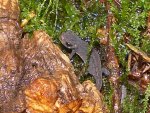GeoNewt
Member
I recently acquired 4 juvenile L. italicus that were bred in the UK earlier this year. I had heard that they are a very small newt, but even so the juveniles are tiny! They are currently housed in 12x8x8" glass tank with a 2/3 plastic, 1/3 mesh lid. It has a substrate of orchid bark and live moss, and there are a couple of cork bark hides and a shallow water dish. They are currently feeding well on crickets and live bloodworm. I have been struggling to find any information about this species on the web, and so I am asking anyone with experience with this or any other lissotriton species if there are any specific husbandry needs, or if there is anything I'm doing wrong? I wondered about the size of tank - would I be better off putting them in a smaller tank where it might be easier for them to locate food? Any comments will be greatly appreciated.
Sorry about the picture quality - I will try to take some more later this week.


Thanks again,
George.
Sorry about the picture quality - I will try to take some more later this week.


Thanks again,
George.




